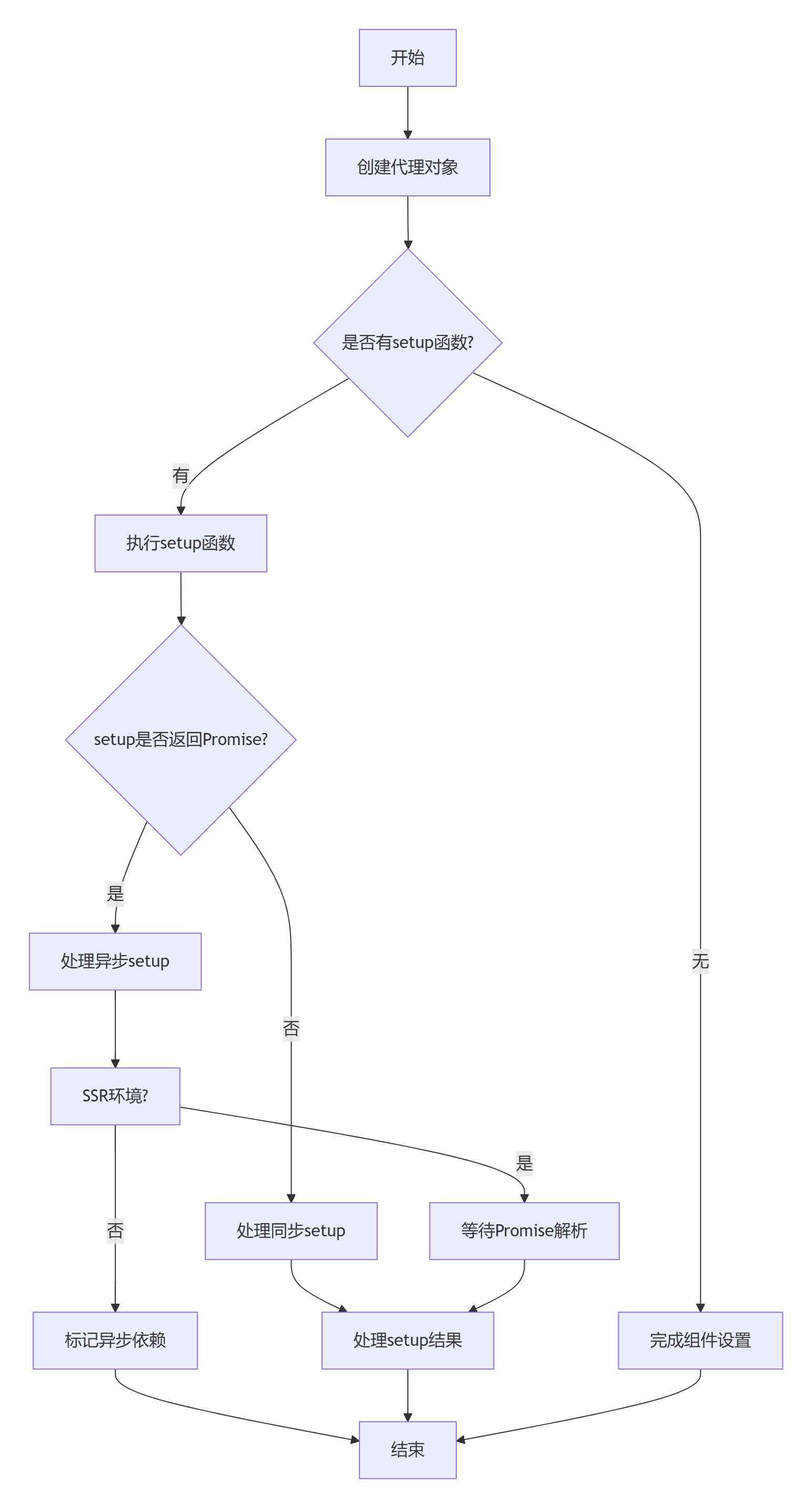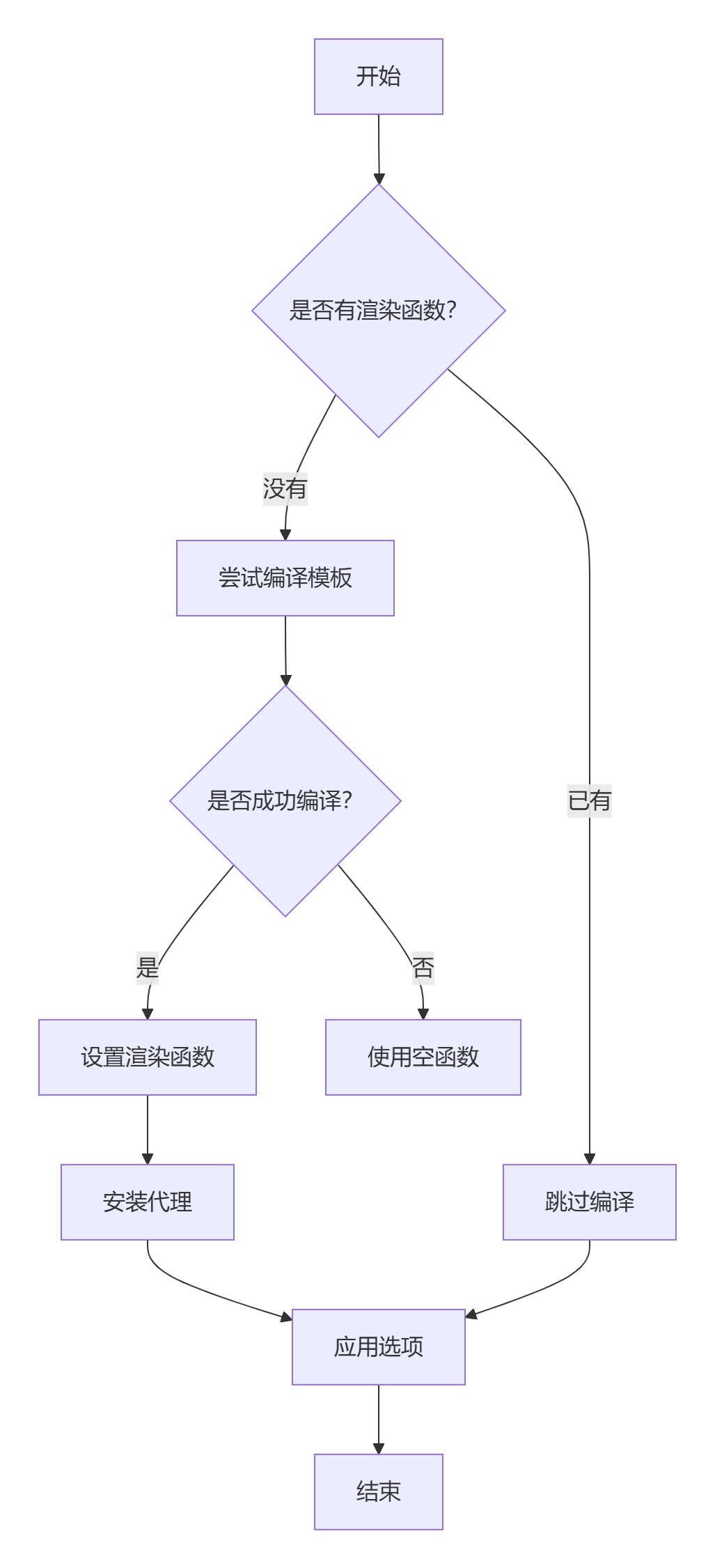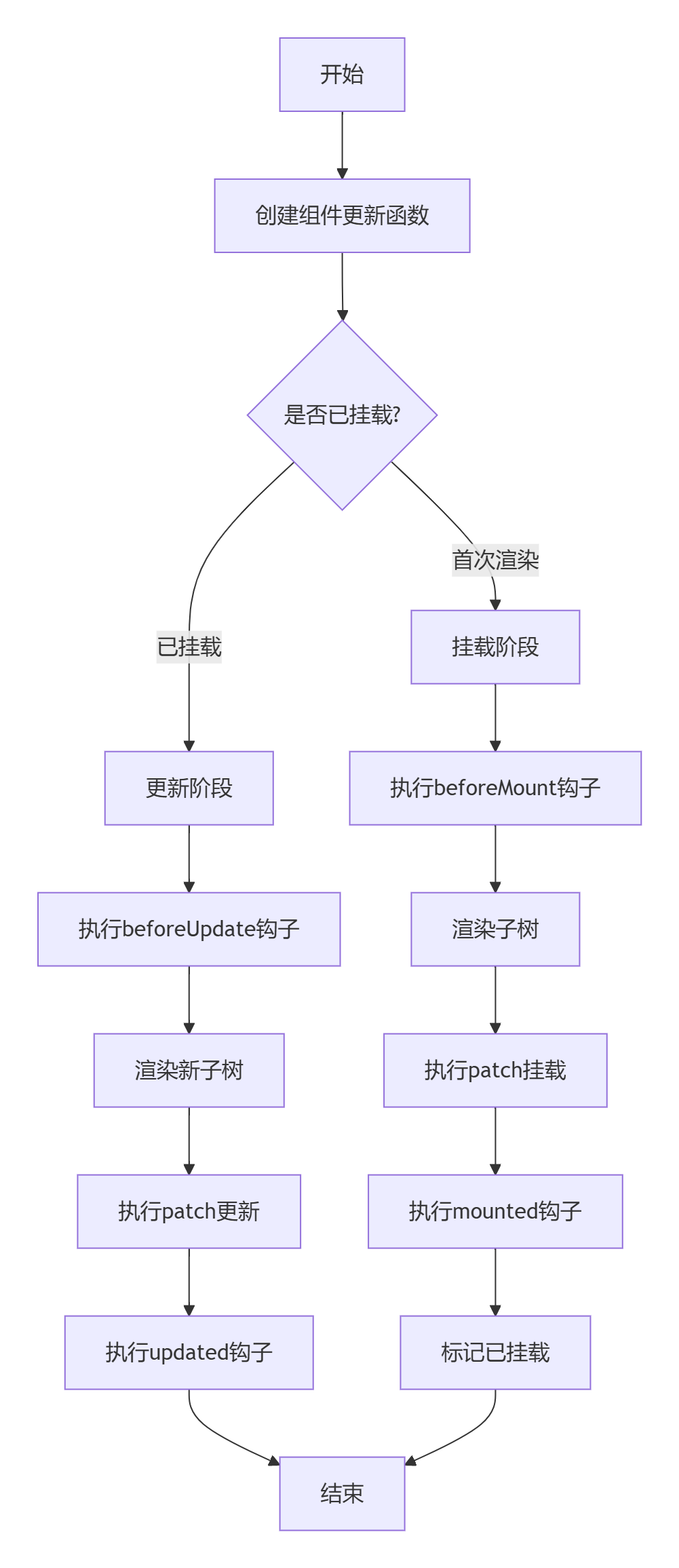 patch中组件的挂载解析
patch中组件的挂载解析
# 概览
patch中处理组件时,会调用processComponent方法,在processComponent中,若旧节点n1为null,且新节点n2的shapeFlag判断不为keepAlive,则会调用mountComponent方法挂载节点n2,mountComponent方法在组件初始化时就会被调用。
# 源码解析
# mountComponent组件挂载
mountComponent方法的参数说明如下:
initialVNode:初始虚拟节点n2container:容器元素anchor:锚点parentComponent:父组件parentSuspense:异步父组件namespace:命名空间optimized:是否优化标志
mountComponent源码如下:
const mountComponent = (initialVNode, container, anchor, parentComponent, parentSuspense, namespace, optimized) => {
// 调用createComponentInstance创建组件实例instance
const instance = (initialVNode.component = createComponentInstance(initialVNode, parentComponent, parentSuspense));
// 判断节点是否是keepAlive组件
if (isKeepAlive(initialVNode)) {
// 若是,则设置组件实例上下文的渲染器renderer方法
instance.ctx.renderer = internals;
}
// 设置组件实例
setupComponent(instance, false, optimized);
// 处理异步组件
if (instance.asyncDep) {
// 若组件实例有异步依赖,且存在父级异步,则调用registerDep注册依赖
parentSuspense && parentSuspense.registerDep(instance, setupRenderEffect, optimized);
if (!initialVNode.el) {
// 若虚拟节点的el不存在在,则创建注释节点用以占位
const placeholder = instance.subTree = createVNode(Comment);
processCommentNode(null, placeholder, container, anchor);
initialVNode.placeholder = placeholder.el;
}
} else {
// 如果没有异步依赖,则调用setupRenderEffect设置渲染效果
setupRenderEffect(instance, initialVNode, container, anchor, parentSuspense, namespace, optimized);
}
}
2
3
4
5
6
7
8
9
10
11
12
13
14
15
16
17
18
19
20
21
22
23
24
25
mountComponent方法会先调用createComponentInstance创建组件实例,并将其关联到虚拟节点(initialVNode.component),然后判断是否是KeepAlive组件,若是,则设置组件实例上下文的渲染器方法。再就是调用setupComponent初始化组件状态,最后判断组件是否是异步的,若是异步组件,则向父级Suspense注册依赖,回调为setupRenderEffect,并创建注释节点作为占位符;若不存在异步依赖,则就是调用setupRenderEffect进行同步渲染。
# 辅助方法
# createComponentInstance
createComponentInstance用于创建并返回组件实例对象,该实例对象包含组件运行所需的所有状态和方法,是 Vue 组件系统的核心数据结构。
function createComponentInstance(vnode, parent, suspense) {
const type = vnode.type; //虚拟节点类型
// 应用上下文
const appContext = (parent ? parent.appContext : vnode.appContext) || emptyAppContext;
const instance = {
uid: uid++,// 唯一标识,
vnode, // 关联的虚拟节点
type, // 组件类型,用以区分是组件选项对象或函数组件
parent,// 父组件实例
appContext,// 应用上下文,继承自父组件或使用vnode上的appContext
root: null, // 根组件实例,如果当前是根组件,则指向自身;否则指向父组件的根
next: null,// 新的组件实例(用于更新)
subTree: null, // 组件的子树(即render函数返回的VNode树)
effect: null,// 响应式effect(用于组件的渲染和更新)
update: null,// 组件的更新函数,会在setupRenderEffect中设置
job: null,// 在调度器中的任务(用于调度更新)
scope: new reactivity.EffectScope(
true
), // EffectScope实例,用于管理该组件内的响应式effect(如计算属性、watch等),当组件卸载时会自动停止这些副作用effect
render: null,// 组件的渲染函数
proxy: null,// 组件实例的代理对象,(用于模版访问,如this.xxx)
exposed: null,// 通过expose暴露的公共属性
exposeProxy: null,// 暴露的代理对象,即expose的代理
withProxy: null,//在with块中使用的代理(用于编译模式)
provides: parent ? parent.provides : Object.create(appContext.provides),// 依赖注入,继承父组件的provides,或者从appContext中获取(根组件)
ids: parent ? parent.ids : ["", 0, 0],// 用于开发环境跟踪组件
accessCache: null, // 访问缓存(用于优化属性访问)
renderCache: [],// 渲染缓存 (用于优化渲染,如静态节点)
components: null, // 局部注册的组件
directives: null, // 局部注册的指令
propsOptions: normalizePropsOptions(type, appContext),//规范化后的props选项,用于校验和转换
emitsOptions: normalizeEmitsOptions(type, appContext),//规范化后的emits选项,用于校验
emit: null,//事件触发函数
emitted: null,// 记录已触发的事件
propsDefaults: shared.EMPTY_OBJ,//props的默认值
inheritAttrs: type.inheritAttrs,//是否继承非props的属性(组件选项)
ctx: shared.EMPTY_OBJ,// 上下文对象
data: shared.EMPTY_OBJ,// 组件的数据对象(Options API中的data返回的对象)
props: shared.EMPTY_OBJ,// 组件的props对象
attrs: shared.EMPTY_OBJ,// 非props的属性
slots: shared.EMPTY_OBJ,// 插槽对象
refs: shared.EMPTY_OBJ,// 模版refs对象
setupState: shared.EMPTY_OBJ,// Composition API中setup函数返回的状态对象
setupContext: null,// setup函数的上下文(包含attrs、slots、emit等)
// suspense related
suspense,// 关联的Suspense实例
suspenseId: suspense ? suspense.pendingId : 0, //Suspense的pendingId,用于跟踪异步状态
asyncDep: null, //异步依赖
asyncResolved: false,// 表示异步依赖是否已解析
isMounted: false, // 是否已挂载
isUnmounted: false, // 是否已卸载
isDeactivated: false, //是否已停用
// 以下用于存储用户定义的生命周期钩子,数组形式
bc: null,// beforeCreate
c: null, // created
bm: null, // beforeMount
m: null, // mounted
bu: null, // beforeUpdate
u: null, // updated
um: null, // unmounted
bum: null, // beforeUnmounted
da: null, // deactivated
a: null, // activated
rtg: null, // beforeRouteUpdate,Vue Router 钩子
rtc: null, // beforeRouteLeave, Vue Router 钩子
ec: null, // errorCaptured
sp: null // serverPrefetch SSR
};
{
instance.ctx = { _: instance };
}
instance.root = parent ? parent.root : instance;
instance.emit = emit.bind(null, instance);
if (vnode.ce) {
vnode.ce(instance);
}
return instance;
}
2
3
4
5
6
7
8
9
10
11
12
13
14
15
16
17
18
19
20
21
22
23
24
25
26
27
28
29
30
31
32
33
34
35
36
37
38
39
40
41
42
43
44
45
46
47
48
49
50
51
52
53
54
55
56
57
58
59
60
61
62
63
64
65
66
67
68
69
70
71
72
73
74
75
76
77
78
createComponentInstance方法如上定义实例对象,并将ctx._指向实例自身,设置root属性,以及将emit函数绑定到当前实例;如果vnode有ce(即custom element回调),则调用,最后返回实例对象instance。
# setupComponent
setupComponent方法用于初始化组件状态,其核心初始化操作如下:
- 解析
props/attrs - 初始化
slots - 执行
Composition API的setup()函数 - 建立响应式状态(
reactive/ref)等
setupComponent的源码实现如下:
function setupComponent(instance, isSSR = false, optimized = false) {
isSSR && setInSSRSetupState(isSSR);
// 从虚拟节点中解构出props和children
const { props, children } = instance.vnode;
// 判断当前组件是否是有状态组件
const isStateful = isStatefulComponent(instance);
// 调用initProps初始化组件的props
initProps(instance, props, isStateful, isSSR);
// 调用initSlots初始化组件的子节点
initSlots(instance, children, optimized || isSSR);
const setupResult = isStateful ? setupStatefulComponent(instance, isSSR) : void 0;
isSSR && setInSSRSetupState(false);
return setupResult;
}
2
3
4
5
6
7
8
9
10
11
12
13
14
这里不展开讲initProps和initSlots和服务端渲染的情况。setupComponent中会调用setupStatefulComponent设置状态组件。
# setupStatefulComponent
setupStatefulComponent顾名思义就是设置状态组件。主要处理组件的setup函数,并设置组件的实例代理。
setupStatefulComponent的源码实现如下:
function setupStatefulComponent(instance, isSSR) {
// 获取组件选项
const Component = instance.type;
// 设置组件的属性访问值
instance.accessCache = Object.create(null);
// 创建组件的代理对象,用于在模版和setup中访问组件实例的属性如props、data等
instance.proxy = new Proxy(instance.ctx, PublicInstanceProxyHandlers);
// 解构setup函数
const { setup } = Component;
// 若setup存在
if (setup) {
// 暂停依赖收集
reactivity.pauseTracking();
// 设置setup函数的上下文,若setup函数的参数个数大于1,则调用createSetupContext创建上下文
const setupContext = instance.setupContext = setup.length > 1 ? createSetupContext(instance) : null;
// 设置当前实例
const reset = setCurrentInstance(instance);
// 通过callWithErrorHandling调用setup函数
const setupResult = callWithErrorHandling(
setup,
instance,
0,
[
instance.props,
setupContext
] // setup的参数
);
// 判断setup的返回结果是否是异步的
const isAsyncSetup = shared.isPromise(setupResult);
// 恢复依赖收集
reactivity.resetTracking();
// 重置当前实例
reset();
// 如果是异步setup或者有serverPrefetch并且不是异步包装组件,则标记为异步边界
if ((isAsyncSetup || instance.sp) && !isAsyncWrapper(instance)) {
markAsyncBoundary(instance);
}
// 处理异步setup
if (isAsyncSetup) {
setupResult.then(unsetCurrentInstance, unsetCurrentInstance);
if (isSSR) {
// 在ssr中,等待Promise完成再处理结果
return setupResult.then((resolvedResult) => {
handleSetupResult(instance, resolvedResult, isSSR);
}).catch((e) => {
handleError(e, instance, 0);
});
} else {
// 将结果存储在asyncDep中,后续由Suspense或异步组件处理
instance.asyncDep = setupResult;
}
} else {
// 处理同步setup,直接调用handleSetupResult方法
handleSetupResult(instance, setupResult, isSSR);
}
} else {
// 若setup函数不存在,则调用finishComponentSetup完成组件设置
finishComponentSetup(instance, isSSR);
}
}
2
3
4
5
6
7
8
9
10
11
12
13
14
15
16
17
18
19
20
21
22
23
24
25
26
27
28
29
30
31
32
33
34
35
36
37
38
39
40
41
42
43
44
45
46
47
48
49
50
51
52
53
54
55
56
57
58
59
60
函数流程

# handleSetupResult
在setupStatefulComponent方法中,若组件存在setup函数,则会执行setup函数,并且调用handleSetupResult方法处理setup的返回值。
function handleSetupResult(instance, setupResult, isSSR) {
// 若setupResult是一个函数
if (shared.isFunction(setupResult)) {
// 判断组件选项是否存在__ssrInlineRender
if (instance.type.__ssrInlineRender) {
// 若存在,则将setupResult赋给组件实例的ssrRender
instance.ssrRender = setupResult;
} else {
// 若不存在,则将其赋给实例的render属性
instance.render = setupResult
}
} else if (shared.isObject(setupResult)) {
// 若 setupResult是一个对象,则通过响应式系统将其包装为包含ref的代理对象,并且赋值给实例的setupState属性
instance.setupState = reactivity.proxyRefs(setupResult);
}
// 最后调用finishComponentSetup方法完成实例的设置
finishComponentSetup(instance, isSSR);
}
2
3
4
5
6
7
8
9
10
11
12
13
14
15
16
17
18
# finishComponentSetup
finishComponentSetup方法用于完成组件的设置,特别是处理选项式API的组件。
function finishComponentSetup(instance, isSSR) {
// 获取组件选项
const Component = instance.type;
if (!instance.render) {
// 若组件实例没有render函数
if (!isSSR && compile && !Component.render) {
// 若在非ssr环境,且编译器函数存在,组件选项中没有定义render函数
const template = Component.template || resolveMergedOptions(instance).template;
// 获取模版
if (template) {
// 若模版存在,则合并编译器选项
const { isCustomElement, compilerOptions } = instance.appContext.config;
const { delimiters, compilerOptions: componentCompilerOptions } = Component;
const finalCompilerOptions = shared.extend(shared.extend({ isCustomElement, delimiters }, compilerOptions), componentCompilerOptions)
// 编译模版为渲染函数
Component.render = compile(template, finalCompilerOptions)
}
}
// 设置实例的渲染函数
instance.render = Component.render || shared.NOOP;
// 开发环境安装代理
if (installWithProxy) {
installWithProxy(instance);
}
}
// 设置当前实例
const reset = setCurrentInstance(instance);
// 暂停依赖收集
reactivity.pauseTracking();
try {
// 处理选项式API
applyOptions(instance);
} finally {
// 恢复依赖收集
reactivity.resetTracking();
// 重置实例
reset();
}
}
2
3
4
5
6
7
8
9
10
11
12
13
14
15
16
17
18
19
20
21
22
23
24
25
26
27
28
29
30
31
32
33
34
35
36
37
38
39
40
41
处理流程 
# applyOptions
applyOptions主要是处理选项式API的核心函数,负责将传统的组件选项式转换为组合式API的实现。
function applyOptions(instance) {
// 解析合并选项,主要是合并全局混入、组件继承和自身选项,生成最终的组件选项对象
const options = resolveMergedOptions(instance);
// 组件的代理对象
const publicThis = instance.proxy;
// 组件实例的上下文
const ctx = instance.ctx;
shouldCacheAccess = false;
// 调用beforeCreate,此时实例尚未完全初始化
if (options.beforeCreate) {
callHook(options.beforeCreate, instance, "bc");
}
// 解构选项
const {
// state
data: dataOptions,
computed: computedOptions,
methods,
watch: watchOptions,
provide: provideOptions,
inject: injectOptions,
// lifecycle
created,
beforeMount,
mounted,
beforeUpdate,
updated,
activated,
deactivated,
beforeDestroy,
beforeUnmount,
destroyed,
unmounted,
render,
renderTracked,
renderTriggered,
errorCaptured,
serverPrefetch,
// public API
expose,
inheritAttrs,
// assets
components,
directives,
filters
} = options;
const checkDuplicateProperties = null;
// 处理依赖注入,从祖先组件的provide中获取值,然后注入到组件上下文
if (injectOptions) {
resolveInjections(injectOptions, ctx, checkDuplicateProperties);
}
// 处理绑定方法
if (methods) {
// 遍历,然后将methods中的函数绑定到组件上下文中,并且通过bind绑定方法内的this指向组件代理
for (const key in methods) {
const methodHandler = methods[key];
if (shared.isFunction(methodHandler)) {
{
ctx[key] = methodHandler.bind(publicThis);
}
}
}
}
// 处理初始化数据
if (dataOptions) {
// 调用data函数获取原始数据,通过reactive将其转为响应式对象,存储到instance.data中
const data = dataOptions.call(publicThis, publicThis);
if (!shared.isObject(data)); else {
instance.data = reactivity.reactive(data);
}
}
shouldCacheAccess = true;
// 处理计算属性
if (computedOptions) {
for (const key in computedOptions) {
const opt = computedOptions[key];
const get = shared.isFunction(opt) ? opt.bind(publicThis, publicThis) : shared.isFunction(opt.get) ? opt.get.bind(publicThis, publicThis) : shared.NOOP;
const set = !shared.isFunction(opt) && shared.isFunction(opt.set) ? opt.set.bind(publicThis) : shared.NOOP;
// 创建计算属性
const c = computed({
get,
set
});
// 在上下文上定义访问器
Object.defineProperty(ctx, key, {
enumerable: true,
configurable: true,
get: () => c.value,
set: (v) => c.value = v
});
}
}
// 处理watch
if (watchOptions) {
for (const key in watchOptions) {
createWatcher(watchOptions[key], ctx, publicThis, key);
}
}
// 处理依赖
if (provideOptions) {
const provides = shared.isFunction(provideOptions) ? provideOptions.call(publicThis) : provideOptions;
Reflect.ownKeys(provides).forEach((key) => {
provide(key, provides[key]);
});
}
// 调用created钩子函数,此时状态初始化完成
if (created) {
callHook(created, instance, "c");
}
function registerLifecycleHook(register, hook) {
if (shared.isArray(hook)) {
hook.forEach((_hook) => register(_hook.bind(publicThis)));
} else if (hook) {
register(hook.bind(publicThis));
}
}
// 注册生命周期钩子
registerLifecycleHook(onBeforeMount, beforeMount);
registerLifecycleHook(onMounted, mounted);
registerLifecycleHook(onBeforeUpdate, beforeUpdate);
registerLifecycleHook(onUpdated, updated);
registerLifecycleHook(onActivated, activated);
registerLifecycleHook(onDeactivated, deactivated);
registerLifecycleHook(onErrorCaptured, errorCaptured);
registerLifecycleHook(onRenderTracked, renderTracked);
registerLifecycleHook(onRenderTriggered, renderTriggered);
registerLifecycleHook(onBeforeUnmount, beforeUnmount);
registerLifecycleHook(onUnmounted, unmounted);
registerLifecycleHook(onServerPrefetch, serverPrefetch);
// 处理expose,控制组件对外暴露的公共接口
if (shared.isArray(expose)) {
if (expose.length) {
const exposed = instance.exposed || (instance.exposed = {});
expose.forEach((key) => {
Object.defineProperty(exposed, key, {
get: () => publicThis[key],
set: (val) => publicThis[key] = val,
enumerable: true
});
});
} else if (!instance.exposed) {
instance.exposed = {};
}
}
// 设置组件的渲染函数
if (render && instance.render === shared.NOOP) {
instance.render = render;
}
// 设置属性继承行为
if (inheritAttrs != null) {
instance.inheritAttrs = inheritAttrs;
}
// 注册局部组件
if (components) instance.components = components;
// 注册局部指令
if (directives) instance.directives = directives;
if (serverPrefetch) {
markAsyncBoundary(instance);
}
}
2
3
4
5
6
7
8
9
10
11
12
13
14
15
16
17
18
19
20
21
22
23
24
25
26
27
28
29
30
31
32
33
34
35
36
37
38
39
40
41
42
43
44
45
46
47
48
49
50
51
52
53
54
55
56
57
58
59
60
61
62
63
64
65
66
67
68
69
70
71
72
73
74
75
76
77
78
79
80
81
82
83
84
85
86
87
88
89
90
91
92
93
94
95
96
97
98
99
100
101
102
103
104
105
106
107
108
109
110
111
112
113
114
115
116
117
118
119
120
121
122
123
124
125
126
127
128
129
130
131
132
133
134
135
136
137
138
139
140
141
142
143
144
145
146
147
148
149
150
151
152
153
154
155
156
157
158
159
160
161
applyOptions主要就是兼容选项式API的核心,其流程图如下

# setupRenderEffect
上述的辅助方法均是setupComponent的后续操作,都和状态数据相关,而组件的渲染则是由setupRenderEffect完成。
const setupRenderEffect = (instance, initialVNode, container, anchor, parentSuspense, namespace, optimized) => {
const componentUpdateFn = () => {
if (!instance.isMounted) {
// 首次挂载逻辑
// 解构虚拟节点中的el和props
const { el, props } = initialVNode;
// 获取beforeMount和mounted
const { bm, m, parent, root, type } = instance;
// 判断是否是异步的虚拟节点
const isAsyncWrapperVNode = isAsyncWrapper(initialVNode);
// 暂停递归追踪
toggleRecurse(instance, false);
if (bm) {
// 若存在beforeMount钩子函数,则调用
shared.invokeArrayFns(bm);
}
// 若不是异步节点,且存在onVnodeBeforeMount钩子,则调用
if (!isAsyncWrapperVNode && (vnodeHook = props && props.onVnodeBeforeMount)) {
invokeVNodeHook(vnodeHook, parent, initialVNode);
}
// 恢复递归追踪
toggleRecurse(instance, true);
// 若el和水合节点函数都存在,
if (el && hydrateNode) {
// 定义水合子树
const hydrateSubTree = () => {
instance.subTree = renderComponentRoot(instance);
hydrateNode(
el,
instance.subTree,
instance,
parentSuspense,
null
);
};
// 若是异步组件且需要水合,则进行异步水合
if (isAsyncWrapperVNode && type.__asyncHydrate) {
type.__asyncHydrate(
el,
instance,
hydrateSubTree
);
} else {
hydrateSubTree();
}
} else {
if (root.ce && // @ts-expect-error _def is private
root.ce._def.shadowRoot !== false) {
root.ce._injectChildStyle(type);
}
// 调用renderComponentRoot生成子树
const subTree = instance.subTree = renderComponentRoot(instance);
// 调用patch进行子树挂载
patch(
null,
subTree,
container,
anchor,
instance,
parentSuspense,
namespace
);
// 将子树的el设置为初始节点的el
initialVNode.el = subTree.el;
}
// 若存在mounted钩子,则将其通过queuePostRenderEffect延迟执行
if (m) {
queuePostRenderEffect(m, parentSuspense);
}
// 若是同步节点,且存在onVnodeMounted钩子,则将其推入到队列中国等待执行
if (!isAsyncWrapperVNode && (vnodeHook = props && props.onVnodeMounted)) {
const scopedInitialVNode = initialVNode;
queuePostRenderEffect(
() => invokeVNodeHook(vnodeHook, parent, scopedInitialVNode),
parentSuspense
);
}
// 如果是异步包装器或者父组件是异步包装器且实例存在activated钩子,则将该钩子推入到队列中等待执行
if (initialVNode.shapeFlag & 256 || parent && isAsyncWrapper(parent.vnode) && parent.vnode.shapeFlag & 256) {
instance.a && queuePostRenderEffect(instance.a, parentSuspense);
}
//标记组件已经挂载
instance.isMounted = true;
// 重置几个属性
initialVNode = container = anchor = null;
} else {
// 更新逻辑
// 从实例中解构出新组件,beforeUpdate,updated钩子,父组件,虚拟组件
let { next, bu, u, parent, vnode } = instance;
// 从当前组件实例向上查找,找到尚未完成水合的异步根组件
const nonHydratedAsyncRoot = locateNonHydratedAsyncRoot(instance);
if (nonHydratedAsyncRoot) {
// 若存在尚未水合的异步根组件
if (next) {
// 若存在新节点
next.el = vnode.el;//保持DOM元素引用
// 调用updateComponentPreRender进行预渲染
updateComponentPreRender(instance, next, optimized);
}
nonHydratedAsyncRoot.asyncDep.then(() => {
// 等待异步根组件的依赖解析完成,然后重新执行组件更新
if (!instance.isUnmounted) {
componentUpdateFn();
}
});
return
}
// 准备更新
let originNext = next;
let vnodeHook;
// 暂停递归依赖收集
toggleRecurse(instance, false);
if (next) {
// 若新节点存在,
next.el = vnode.el;//保持DOM元素引用
// 进行与渲染
updateComponentPreRender(instance, next, optimized);
} else {
// 若没有新VNode,则使用当前vnode
next = vnode;
}
// 若存在beforeUpdate钩子,则调用
if (bu) {
shared.invokeArrayFns(bu);
}
// 若存在onVnodeBeforeUpdate,则调用
if (vnodeHook = next.props && next.props.onVnodeBeforeUpdate) {
invokeVNodeHook(vnodeHook, parent, next, vnode);
}
// 恢复递归依赖收集
toggleRecurse(instance, true);
// 调用renderComponentRoot渲染新子树
const nextTree = renderComponentRoot(instance);
const prevTree = instance.subTree;// 保存旧子树
instance.subTree = nextTree;//更新子树引用
// 调用patch进行DOM更新
patch(
prevTree, // 旧子树
nextTree, // 新子树
// parent may have changed if it's in a teleport
hostParentNode(prevTree.el),//父节点
// anchor may have changed if it's in a fragment
getNextHostNode(prevTree), //锚点
instance,
parentSuspense,
namespace
);
next.el = nextTree.el; // 更新新VNode的DOM引用
if (originNext === null) {
// 更新高阶组件的宿主元素
updateHOCHostEl(instance, nextTree.el);
}
// 若存在updated钩子,则将其推入到队列中等待执行
if (u) {
queuePostRenderEffect(u, parentSuspense);
}
// 若存在onVnodeUpdated钩子,则将其推入到队列中更新
if (vnodeHook = next.props && next.props.onVnodeUpdated) {
queuePostRenderEffect(
() => invokeVNodeHook(vnodeHook, parent, next, vnode),
parentSuspense
);
}
}
};
// 开启实例的scope
instance.scope.on();
// 创建响应式effect
const effect = instance.effect = new reactivity.ReactiveEffect(componentUpdateFn);
// 关闭实例的scope
instance.scope.off();
// 将更新方法保存到实例的update上,并且赋值给update,用于立即运行
const update = instance.update = effect.run.bind(effect);
// 定义job任务,放入队列中,用于在调度器中运行
const job = instance.job = effect.runIfDirty.bind(effect);
job.i = instance;
job.id = instance.uid;
// 设置调度器
effect.scheduler = () => queueJob(job);
// 执行渲染
update();
}
2
3
4
5
6
7
8
9
10
11
12
13
14
15
16
17
18
19
20
21
22
23
24
25
26
27
28
29
30
31
32
33
34
35
36
37
38
39
40
41
42
43
44
45
46
47
48
49
50
51
52
53
54
55
56
57
58
59
60
61
62
63
64
65
66
67
68
69
70
71
72
73
74
75
76
77
78
79
80
81
82
83
84
85
86
87
88
89
90
91
92
93
94
95
96
97
98
99
100
101
102
103
104
105
106
107
108
109
110
111
112
113
114
115
116
117
118
119
120
121
122
123
124
125
126
127
128
129
130
131
132
133
134
135
136
137
138
139
140
141
142
143
144
145
146
147
148
149
150
151
152
153
154
155
156
157
158
159
160
161
162
163
164
165
166
167
168
169
170
171
172
173
174
175
176
177
178
179
180
181
182
setupRenderEffect的流程图如下:

# updateComponentPreRender
updateComponentPreRender方法就是组件更新时进行与渲染,本质上就是调用updateProps和updateSlots进行属性更新和插槽更新,以及调用flushPreFlushCbs执行队列中属于同一实例中的前置任务。
const updateComponentPreRender = (instance, nextVNode, optimized) => {
// 更新新节点的component属性值为instance
nextVNode.component = instance;
const prevProps = instance.vnode.props;
// 更新实例的vnode属性
instance.vnode = nextVNode;
// 清空next属性避免重复更新
instance.next = null;
// 更新属性
updateProps(instance, nextVNode.props, prevProps, optimized);
// 更新插槽
updateSlots(instance, nextVNode.children, optimized);
reactivity.pauseTracking();
flushPreFlushCbs(instance);
reactivity.resetTracking();
};
2
3
4
5
6
7
8
9
10
11
12
13
14
15
16
- 01
- Pinia中实现监听action的原理11-28
- 03
- patch中的双端比较快速算法09-25
